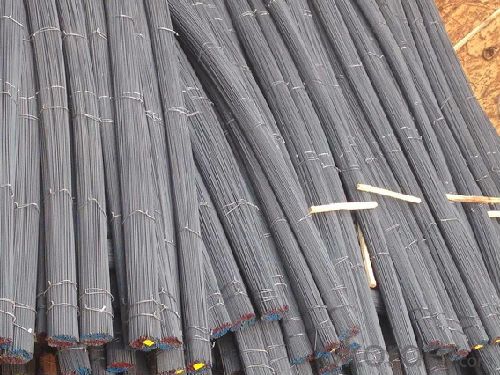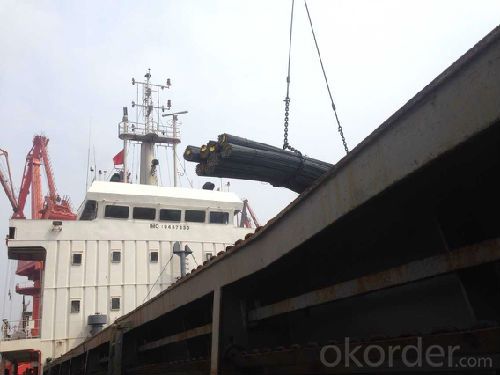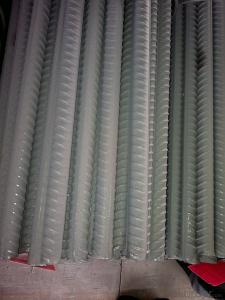Deformed Steel Bar, Iron Rods Bar for Construction/Concrete
- Loading Port:
- China main port
- Payment Terms:
- TT or LC
- Min Order Qty:
- 100 m.t.
- Supply Capability:
- 100000 m.t./month
OKorder Service Pledge
OKorder Financial Service
You Might Also Like
Product Description:
OKorder is offering Deformed Steel Bar, Iron Rods Bar for Construction/Concrete at great prices with worldwide shipping. Our supplier is a world-class manufacturer of steel, with our products utilized the world over. OKorder annually supplies products to African, South American and Asian markets. We provide quotations within 24 hours of receiving an inquiry and guarantee competitive prices.
Product Applications:
Deformed Steel Bar, Iron Rods Bar for Construction/Concrete are ideal for structural applications and are widely used in the construction of buildings and bridges, and the manufacturing, petrochemical, and transportation industries.
Product Advantages:
OKorder's Deformed Steel Bar, Iron Rods Bar for Construction/Concrete are durable, strong, and wide variety of sizes.
Main Product Features:
· Premium quality
· Prompt delivery & seaworthy packing (30 days after receiving deposit)
· Can be recycled and reused
· Mill test certification
· Professional Service
· Competitive pricing
Product Specifications:
Manufacture: Hot rolled
Grade: HRB335,HRB400,HRB500
Certificates: ISO, SGS, BV, CIQ
Length: 6m – 12m, as per customer request
Packaging: Export packing, nude packing, bundled
| DEFORMED BAR | |
| SIZE d(mm) | theoretical kg/m |
| 6 | 0.222 |
| 8 | 0.395 |
| 10 | 0.617 |
| 12 | 0.888 |
| 14 | 1.21 |
| 16 | 1.58 |
| 18 | 2 |
| 20 | 2.47 |
| 22 | 2.98 |
| 25 | 3.85 |
| 28 | 4.83 |
| 32 | 6.31 |
FAQ:
Q1: Why buy Materials & Equipment from OKorder.com?
A1: All products offered byOKorder.com are carefully selected from China's most reliable manufacturing enterprises. Through its ISO certifications, OKorder.com adheres to the highest standards and a commitment to supply chain safety and customer satisfaction.
Q2: How do we guarantee the quality of our products?
A2: We have established an advanced quality management system which conducts strict quality tests at every step, from raw materials to the final product. At the same time, we provide extensive follow-up service assurances as required.
Q3: How soon can we receive the product after purchase?
A3: Within three days of placing an order, we will arrange production. The normal sizes with the normal grade can be produced within one month. The specific shipping date is dependent upon international and government factors, the delivery to international main port about 45-60days.
Images:


- Q:How do steel rebars perform in structures subjected to vibration?
- Steel rebars perform well in structures subjected to vibration due to their high tensile strength and stiffness. The reinforcement provided by rebars enhances the structural integrity, preventing cracking or failure under dynamic loads. Additionally, the damping characteristics of steel rebars help dissipate the energy generated by vibrations, reducing the potential for damage or resonance effects. Overall, steel rebars play a crucial role in enhancing the durability and stability of structures exposed to vibration.
- Q:Can steel rebars be used in nuclear power plants?
- Yes, steel rebars can be used in nuclear power plants. However, they need to meet stringent quality control standards and be specifically designed to withstand the demanding conditions and potential exposure to radiation in a nuclear power plant environment.
- Q:How do steel rebars affect the flexural strength of reinforced concrete elements?
- The flexural strength of reinforced concrete elements is greatly influenced by steel rebars. Rebars improve the ability of concrete elements to withstand bending or flexural forces. To provide tensile strength, high-strength steel rebars are embedded within the concrete. Concrete is strong when compressed but weak when subjected to tension. By incorporating rebars, the resulting composite material benefits from the concrete's high compressive strength and the steel's excellent tensile strength. When a flexural load is applied to a reinforced concrete element, such as a beam or slab, the rebars distribute the load across the section. This effectively resists the concrete's tendency to crack and fail under tension. Acting as reinforcements, the rebars resist the tensile forces that occur due to bending, thus increasing the structure's flexural strength. The flexural strength of reinforced concrete elements is greatly influenced by the size, spacing, and arrangement of the rebars. Proper design and placement of rebars ensure optimal resistance to anticipated bending forces. Factors such as the element's span, expected loads, and desired strength level must be carefully considered. In addition, the bond between the rebars and the concrete is crucial for transferring bending stresses. Sufficient concrete cover over the rebars protects them from corrosion, ensuring their durability and the integrity of the structure. Corrosion weakens the bond between steel rebars and the surrounding concrete, compromising the flexural strength of the reinforced element. In conclusion, steel rebars greatly enhance the flexural strength of reinforced concrete elements by providing necessary tensile strength to resist bending forces. Proper design, placement, and bonding of rebars are vital to ensuring the durability and structural integrity of reinforced concrete structures.
- Q:Can steel rebars be used in historical restoration projects?
- Yes, steel rebars can be used in historical restoration projects. They provide strength and durability, ensuring the structural integrity of the restored building while preserving its historical significance. However, it is essential to carefully consider and plan the placement of rebars to minimize their visual impact and maintain the authenticity of the historical structure.
- Q:Can steel rebars be used in industrial buildings?
- Yes, steel rebars are commonly used in industrial buildings as they provide excellent reinforcement for concrete structures, enhancing their strength and durability.
- Q:How do steel rebars resist fatigue and creep?
- Steel rebars resist fatigue and creep through their inherent material properties and proper design considerations. Fatigue refers to the gradual weakening of a material under repeated cyclic loading. Steel rebars are specifically designed to withstand fatigue by their high tensile strength and ductility. The tensile strength of steel allows it to resist the stress caused by cyclic loading, while its ductility allows it to deform without fracturing. This combination of properties enables steel rebars to endure numerous load cycles without failure. Additionally, steel rebars can be further enhanced to resist fatigue by employing various techniques such as heat treatment, surface coatings, and alloying. These methods improve the material's fatigue resistance and extend its service life under cyclic loading conditions. Creep, on the other hand, refers to the gradual deformation of a material under constant sustained loading. Steel rebars resist creep through their high stiffness and resistance to plastic deformation. The stiffness of steel allows it to maintain its shape and resist deformation under sustained loads. Moreover, the resistance to plastic deformation prevents excessive stretching or elongation, which can lead to creep failure. Proper design considerations also play a crucial role in enhancing the resistance of steel rebars to fatigue and creep. This includes ensuring appropriate reinforcement spacing, proper anchorage, and adequate concrete cover to protect the rebars from external factors that could induce fatigue or creep. In summary, steel rebars resist fatigue and creep due to their high tensile strength, ductility, stiffness, and resistance to plastic deformation. By utilizing proper design considerations and potentially implementing additional techniques, steel rebars can withstand cyclic loading and sustained loads for extended periods, ensuring their durability and structural integrity.
- Q:Are steel rebars suitable for use in sports stadium construction?
- Yes, steel rebars are suitable for use in sports stadium construction. Steel rebars provide excellent strength and durability, making them ideal for reinforcing concrete structures, such as stadiums, that need to withstand heavy loads and impacts. They enhance the structural integrity of the stadium, ensuring its safety and long-term stability. Additionally, steel rebars offer flexibility in design and can be customized to meet specific construction requirements, making them a preferred choice in sports stadium construction.
- Q:What are the different types of steel rebars used in road construction?
- There are typically two types of steel rebars used in road construction: plain steel bars and deformed steel bars. Plain steel bars are smooth and have no ridges or deformations. Deformed steel bars, on the other hand, have ridges, protrusions, or other patterns on their surface to improve the bond strength between the rebar and the surrounding concrete. Both types of rebars are commonly used in road construction to reinforce and strengthen the concrete structures.
- Q:How do steel rebars help in preventing cracks in concrete?
- Steel rebars help in preventing cracks in concrete by providing reinforcement and increasing the tensile strength of the structure. When concrete is subjected to tensile forces, it tends to crack. However, the presence of steel rebars within the concrete helps distribute these forces, absorbing the tension and preventing cracks from forming or growing. The rebars act like a skeleton, enhancing the structural integrity and durability of the concrete, ensuring it can withstand various loads and external pressures without significant damage.
- Q:What is the role of steel rebars in preventing concrete spalling due to fire?
- The prevention of concrete spalling caused by fire heavily relies on steel rebars. Spalling, which occurs when concrete cracks or flakes off under intense heat, such as during a fire, can be mitigated by embedding steel rebars, also known as reinforcement bars, within the concrete structure. In the event of a fire, the temperature can rapidly rise, causing the moisture within the concrete to transform into steam. This steam generates pressure within the concrete, leading to spalling. However, the presence of steel rebars helps address this issue. Steel possesses a higher melting point than concrete and exhibits exceptional thermal conductivity. When exposed to high temperatures, the steel rebars effectively conduct and disperse heat more efficiently compared to the surrounding concrete. This heat transfer assists in minimizing the temperature gradient within the concrete, thereby reducing the risk of spalling. Moreover, steel rebars serve as reinforcement, ensuring the cohesion of the concrete. In instances of spalling, the rebars aid in maintaining the structural integrity of the concrete by preventing complete disintegration. They provide supplementary strength and support, rendering the concrete more resistant to cracking and breaking. In conclusion, steel rebars are integral in preventing concrete spalling caused by fire. They facilitate heat dissipation, diminish temperature gradients, and offer structural support to the concrete. By enhancing the fire resistance of the concrete, steel rebars contribute to the overall safety and durability of the structure.
1. Manufacturer Overview |
|
|---|---|
| Location | |
| Year Established | |
| Annual Output Value | |
| Main Markets | |
| Company Certifications | |
2. Manufacturer Certificates |
|
|---|---|
| a) Certification Name | |
| Range | |
| Reference | |
| Validity Period | |
3. Manufacturer Capability |
|
|---|---|
| a)Trade Capacity | |
| Nearest Port | |
| Export Percentage | |
| No.of Employees in Trade Department | |
| Language Spoken: | |
| b)Factory Information | |
| Factory Size: | |
| No. of Production Lines | |
| Contract Manufacturing | |
| Product Price Range | |
Send your message to us
Deformed Steel Bar, Iron Rods Bar for Construction/Concrete
- Loading Port:
- China main port
- Payment Terms:
- TT or LC
- Min Order Qty:
- 100 m.t.
- Supply Capability:
- 100000 m.t./month
OKorder Service Pledge
OKorder Financial Service
Similar products
New products
Hot products
Related keywords





























